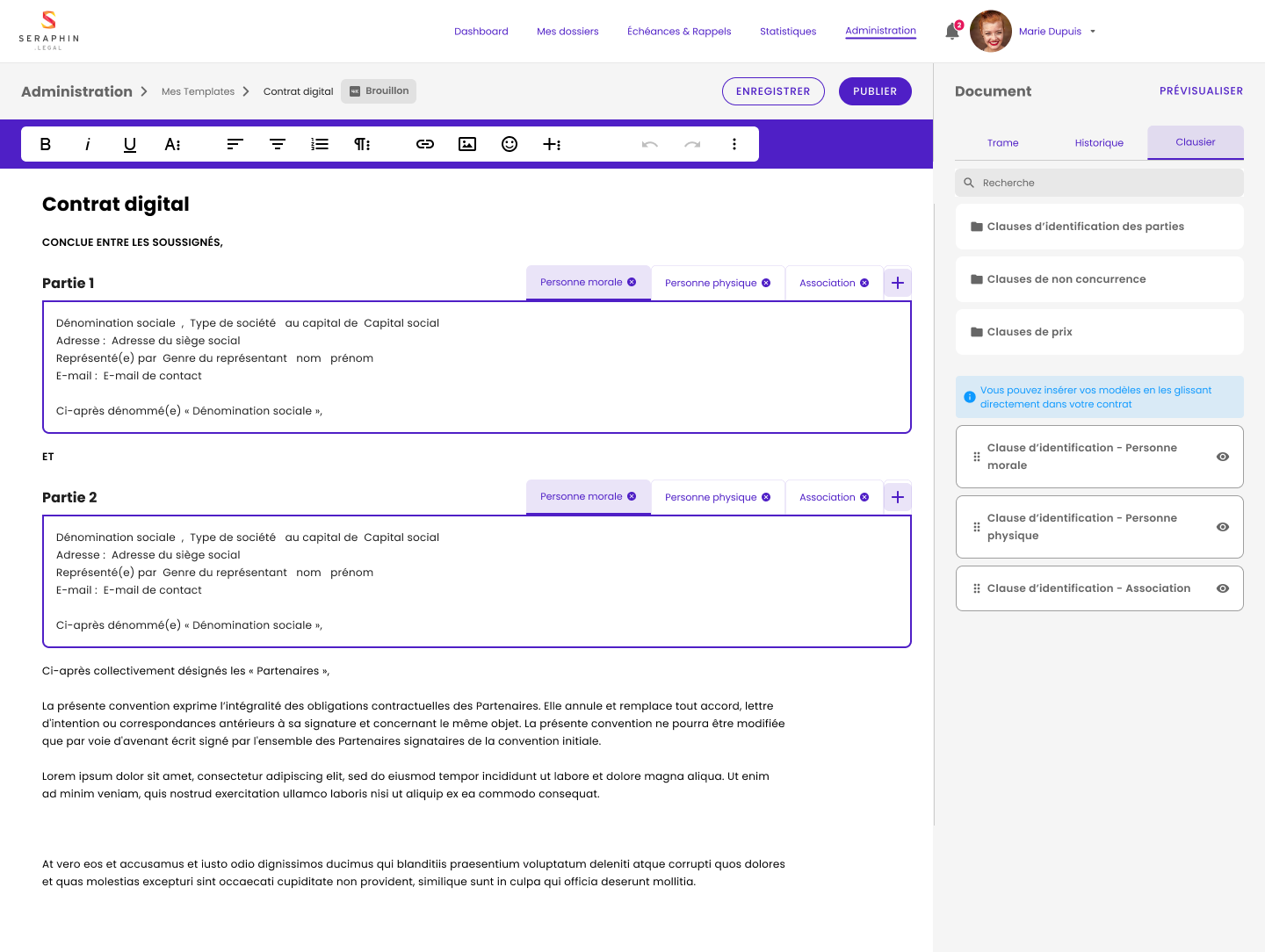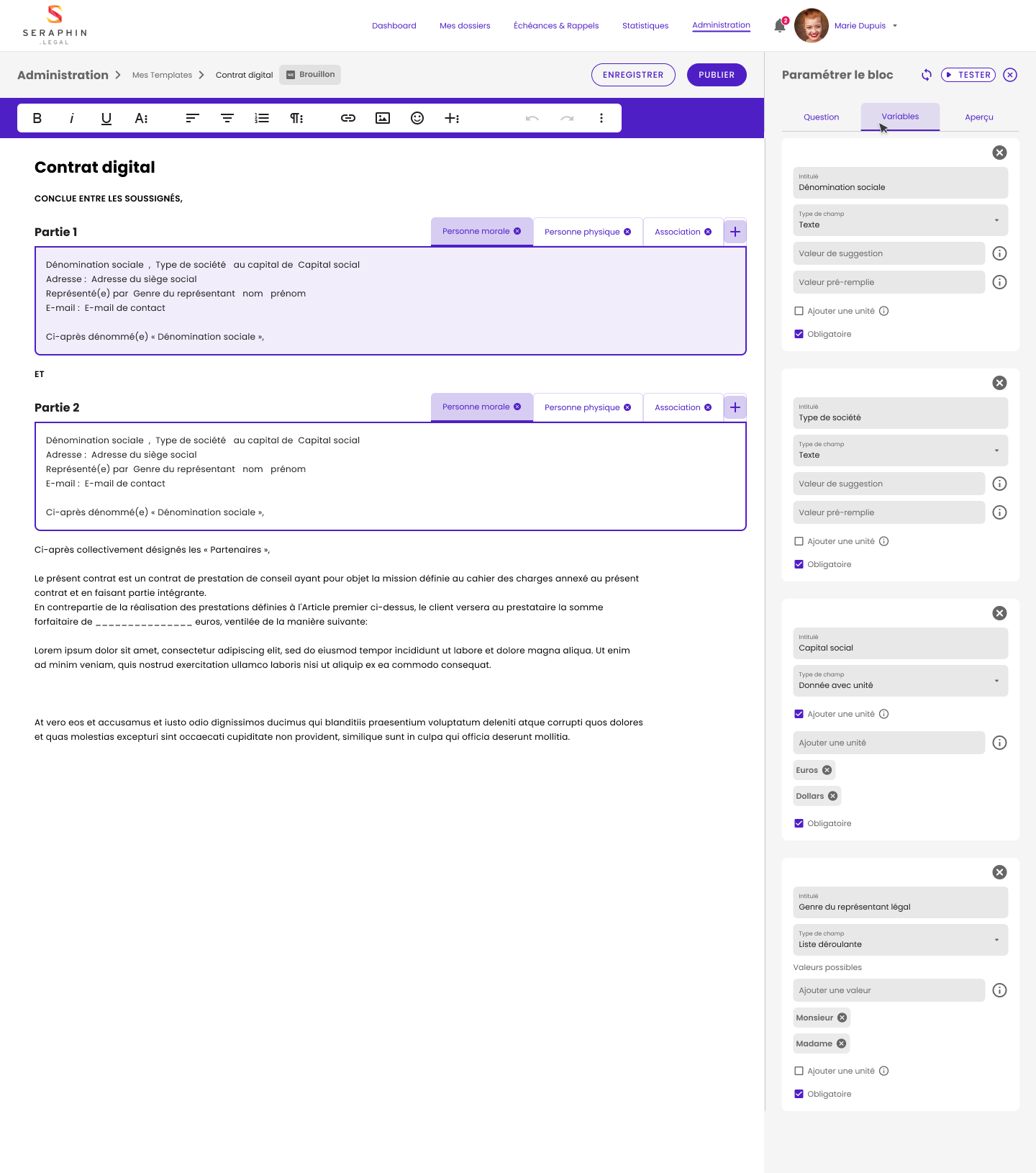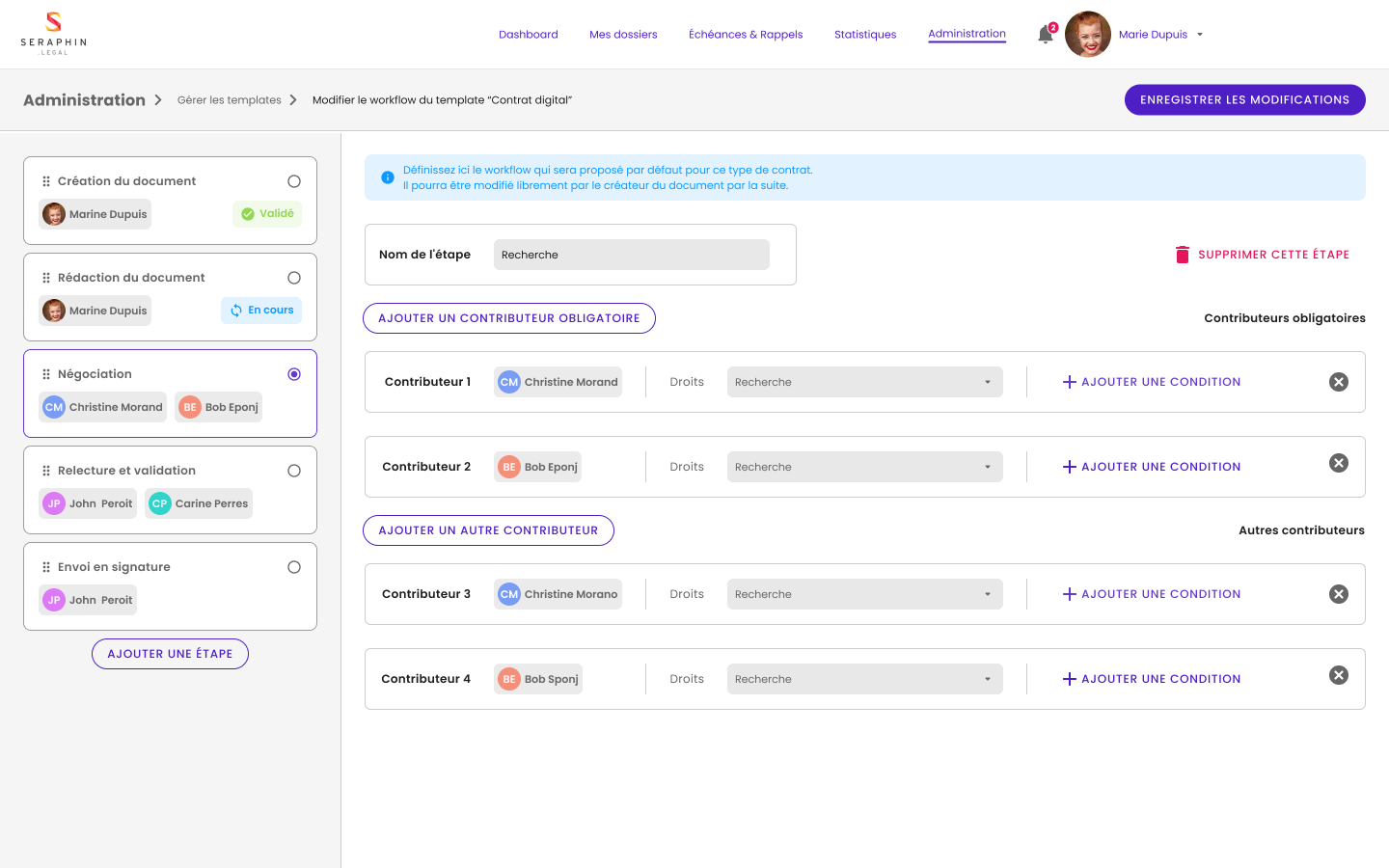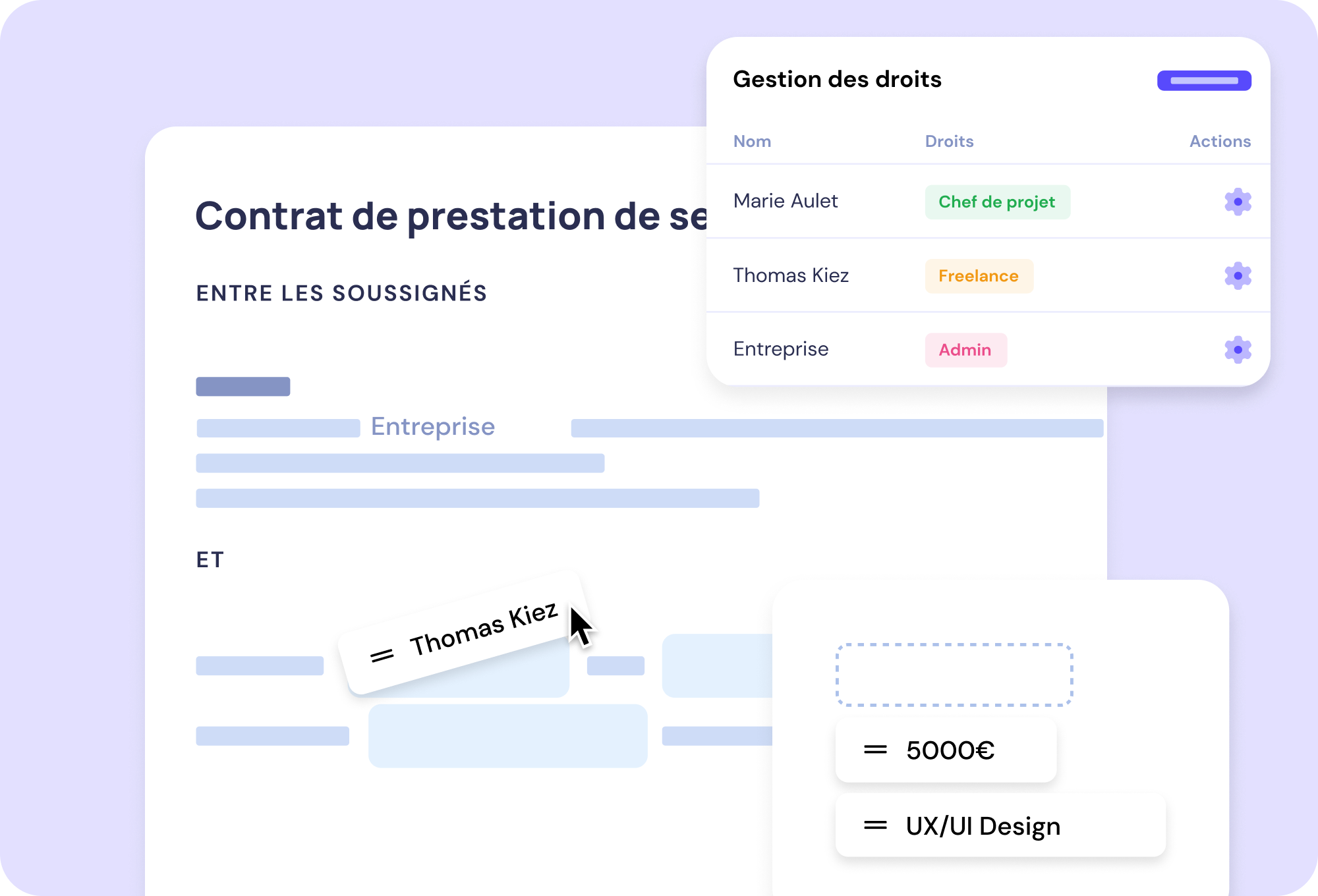What is a contract for the provision of services (freelance)?
The contract for the provision of services, used in the context of a freelance assignment, is the agreement by which a client company hires a worker from outside the company who is self-employed to provide one or more services.
Clausier of the contract for the provision of services (freelance) : Some essential clauses
| Non-competition clause | To avoid the provider working with competitors or creating a similar activity to yours. |
| Transfer of ownership clause | To provide a framework for the transfer of copyright in the context of an artistic creation or industrial design service. |
| Arbitration clause | in the event of a dispute arising from this contract, this will enable you to avoid the courts and opt for an alternative method of settling disputes |
| Objective clause | If the remuneration of the service involves a variable part linked to the achievement of one or more objectives |
| Early termination clause | To provide, according to the type of service, the circumstances that may lead to the early termination of the contract |

Who are the employees concerned internally?
The service contracts for freelance assignments involve various employees within your company, in different ways and especially depending on the use case in which the agreement is made.
Lawyers who have the contract template: they can either create the contract themselves or give their in-house clients some autonomy via a contract library static (non-automated) or dynamic (automated). Generally speaking, lawyers are necessarily involved in the approval of the agreement, especially when it is an NDA concerning a project or strategic information.
Internal operational project manager for this service: Purchasing, HR, Sales, Marketing etc. teams. Anyone who needs to call on a third party to carry out one or more specific assignments. They intervene, depending on the company, during the creation of the contract in complete autonomy thanks to a contract generator.
Manager or delegate legally authorised to sign: this is the person authorised to sign the contract after validation by the legal team and the project manager. On solutions such as Seraphin.legal, the manager or employees with delegated authority are automatically notified of the validation of the agreement and its availability for signature.
| 💡 Good to know: Do you want to set up delegations of authority to empower your teams and make your processes more fluid while being able to manage them? Find out in the same way how to automate a delegation of authority. |
Disadvantages of the traditional process
❌ Waste of time: time-consuming, low-value-added tasks such as drafting contracts do not allow legal teams to focus on strategic operations. Especially since drafting a service contract is not purely and solely legal: whether in the description of the service or other types of clauses.
Read Maëlle Billant's (Contract Manager) testimony on this subject 👇
❌ Loss of autonomy: Why ask the legal team to draft a service contract if they have templates and completion is simple? Operational staff often regret their lack of autonomy and the time it takes to get some simple contracts created while some legal teams fear the legal risk that this autonomy can cause.
❌ Legal risks: Many legal teams offer self-service contract templates in word/google format. As the entire contract can be modified by its user, the risk of deleting a term, a clause, a mandatory mention can generate a major legal and therefore financial risk for the company.
❌ Lack of visibility on the contract: Who was involved in this contract? When? On what date was the contract validated and by whom? What is the main information to be retained from this contract? So much essential information for the company for employees who did not intervene on the contract but who need to collect this information to follow up on the employee or even take over the contract following a departure.
| 💡Feedback: During several exchanges with in-house lawyers and contract managersSome of them told us that contracts and contract forms are transmitted internally through word and excel files and moving hypertext links. This practice can lead to information being lost as people leave or move internally, especially when these files are stored locally. |
❌ Manual reporting: setting up a dashboard and offering regular reporting on contract activity can be a real nightmare when information is scattered and inputting. How many contracts have been signed? On what types of jobs? What is the average time taken to negotiate a service contract? etc.
❌ Lack of reliable deadline monitoring: Once the contract has been drafted, negotiated and signed, it is now time to execute it. Yet it is complex to reliably track contractual data such as the due date of trial periods, target bonuses if they are recorded in an outlook, google or even paper calendar.
💡 Risks of manual recording on a calendar, excel file or sheet of paper: Departure of the employee and deletion of his e-mail address linked to his agenda |
Benefits of an automated process
✅ Time saving: As the legal teams have previously carried out the work of creating a contract library and automating the contracts, they are no longer solicited for the time-consuming aspect of drafting (information gathering, data entry, etc...) but only for their legal expertise (advice, negotiation support, validation etc...).
✅ Leveraging contract data: Beyond simply eliminating time-consuming tasks, automation also ensures data collection. All the data entered to complete a contract is used to enable you to monitor your deadlines, create your contract sheets or even to manage your contractual activity through a statistical dashboard. This data can be communicated with third-party applications used by your company.
✅ Legal security: No more risk of deleting a term, a clause, a mandatory mention that could generate a major legal and financial risk for the company. Only the predetermined and customisable fields can be modified and the rest of the contract is fixed.
| 💡 Good to know: If you have set up the display of a clause to a specific response on the form, this clause cannot be modified by your internal client unless you take action. |
Don't waste any more time signing: Once the service contract has been reviewed and approved by the relevant parties, it is automatically sent for signature to the parties authorised to sign (whether a manager or a delegate).
✅ Gain visibility on the contract: Who was involved in this contract? When did it happen? Who are the internal and external interlocutors? On what date was the contract validated and by whom? What is the main information to be retained from this confidentiality agreement? This is essential information for monitoring, taking over or auditing a contract, which you will find directly on the document's activity feed.
For a quick and easy understanding, each contract has a summary sheet automatically generated from the essential clauses of the contract (object, duration, amount, deadline, etc.). It is even possible to manually enrich the contract form by adding specific items to be displayed.
✅ Reliable monitoring of deadlines: Once a contract has been drafted, negotiated and signed, it is now time to execute it. But it is complex to keep track of contractual data such as your deadlines if they are recorded in an outlook calendar, google or even a paper calendar. If you are a team manager or a lawyer/hr in a company, you have probably already experienced the loneliness of an expired probationary period when you wanted to terminate the contract or renew it.
Find out how the Legal Department of Christophe Dhiver, formerly Kiloutou, saved €400,000 over 2 months thanks to a due date tracking system 👇
How to automate a service contract?
Create a skeleton service contract
In such an automation process, the legal team obviously retains control over the creation of legal acts.
The aim here is to create the legal skeleton, the legally reliable vehicle that complies with the regulations and the company's strategy. It is therefore a standard version that will fit the service contracts most regularly requested by your internal customers.
The following questions should be asked before such a draft:
| Questions | Indications |
| What are the compulsory mentions, clauses or terms in a service contract? | This will give you a first rough and static version of your contract. |
| Which activities do your internal customers most regularly outsource? | This will allow you to prioritise the construction of your workbook according to priority needs. |
| What variables should be customised on the document? | This will enable you to construct your question form for the contract user. |
What are the most common questions managers ask about service contracts?
| This will allow you to provide clarity through the drafting of your questions or through help bubbles to guide contract creators. |
Once you have created this standard contract in Word or Google Doc format, there are two ways to automate it:
- Via direct mail (via extensions such as Merge and Mailing)
- Via a no-code editor dedicated to the automation of contracts such as Seraphin.legal.

Give ownership to your teams via a self-service offer
Have you ever wondered whether it is necessary to intervene in the drafting of such projects? It's time to give your internal clients the means to create their own contracts in complete security so that you can concentrate on your most complex and priority missions.
Thus, your internal customers will be able to personalise their contract from a form that will guide them step by step through the completion of the various fields: date, company name, multiple choice question, unique, contract amount, etc.
The generated contract will be updated in real time in the right-hand panel when you complete the form.
Establish an internal approval system
While it is important to delegate the low-value drafting stage, the approval stage remains crucial.
Indeed, among all the steps in the contract life cycle, the internal validation workflow is essential to ensure the compliance of the commitments and counterparties granted by your company.
In the case of a service contract, the Legal Department will necessarily be able to validate this type of draft contract. However, other parties such as the directors of the client department or the General Management may want to systematically validate certain agreements according to certain types of criteria: everything depends on the company, its challenges, its strategy or its organisation.
With a dedicated platform such as Seraphin.legalyou can determine the rules applicable to approve a document according to your criteria: type of contract, amount, field of activity, etc.

Choose to combine contractual performance and legal certainty
No commitment, no credit card.



